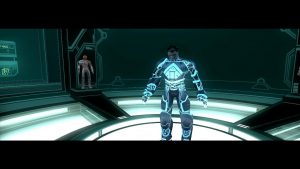Separating Moments of Observation from Moments of Interaction
In all flat-screen games, there is a clear distinction between moments when the player is supposed to be observing the action and moments when the player should be engaging with it. During moments of observation, players take in story and turn off the part of their brain responsible for quick-fire decision making.

A cutscene from Tron 2.0, with magic black bars indicating that the player can simply observe
During moments of interaction, players process the prompts being presented and no longer preoccupy themselves with absorbing narrative information. Flat-screen games have come up with many ways of communicating which way the player should be paying attention. For instance, the presence of two black bars at the top and bottom of the screen let the player know they are watching a cutscene and can metaphorically put the controller down.
One way of showing the player what they should be interacting is with the presence of a button prompt like the image below.
These and other similar techniques fundamentally rely on the notion of the screen. They break down in VR and are no longer applicable. Other methods would have to be implemented to indicate these distinctions to a player.
Blurring the Lines of Observation and Interaction
3rd-person branching narrative games are often described as having “interactive cutscenes” wherein the player is prompted to engaging during a moment of spectatorship. The common discussion around these is that the interaction happens during the cutscene. QTE’s often fall into this conversation. The team believed this idea was true at the beginning of the semester which is why we created a system in which the player engaged interactively at the same time that narrative was pushing forward. However, this was one of the greatest missteps in our design. Players felt like they couldn’t focus on interaction and story at the same time. Players came up with their own balance of how they divided their attention. When players focused on the story, they felt like they were missing moments to interact. When they focused on interactive objects, they would describe the feeling of missing parts of the story. Players simply couldn’t do both. Then how do the flatscreen versions of this genre do it?
The truth is that they don’t do both at once. These games merely jump very quickly between the two. It’s not that interaction and story happen together; it’s that neither persists for very long. A high-paced cutscene may have 1 second of interaction followed by 5 seconds of interaction and back and forth. This would be indicated by the 1 second appearance and subsequent 5 second absence of a button prompt. Yet these “interactive cutscenes” will never have button prompts present at the same time as important narrative developments. Had we realized this earlier, we would have designed the pacing of the interactions differently.
We attempted to remedy this flaw in our interaction design through iterating the script of our story. When players relayed that they felt they were missing story, we added repetition to the dialogue of important plot points. When players relayed that they felt bored by long periods of talking without engagement, we tightened the dialogue. Sometimes, we would get both seemingly mutually-exclusive types of feedback on the same draft of the story. This is because the feedback was actually more related to the individual’s division of attention than the text itself.
Possible fixes to this problem could have been having the scene move into slow motion when a decision was to be made. This would have indicated that it was a moment of interaction and not plot. Then, we would have had no objects available to engage with when the plot should have been focused on. Also, the inclusion of interactions that didn’t affect the story would have given players room to breathe and process the story they were witnessing. Older films from the early 20th century feel slower and longer than modern films because the average length of a shot is much longer than modern editing style. The cuts in a modern film indicate pacing and break the story into more digestible pieces. Because VR lacks a camera, it has no cuts and thus time feels different to the spectator. These superfluous interactions would break the story up the same way cuts do in a film and allow the player to break up the story in their mind. This is why many players described our piece as resembling a radio play.